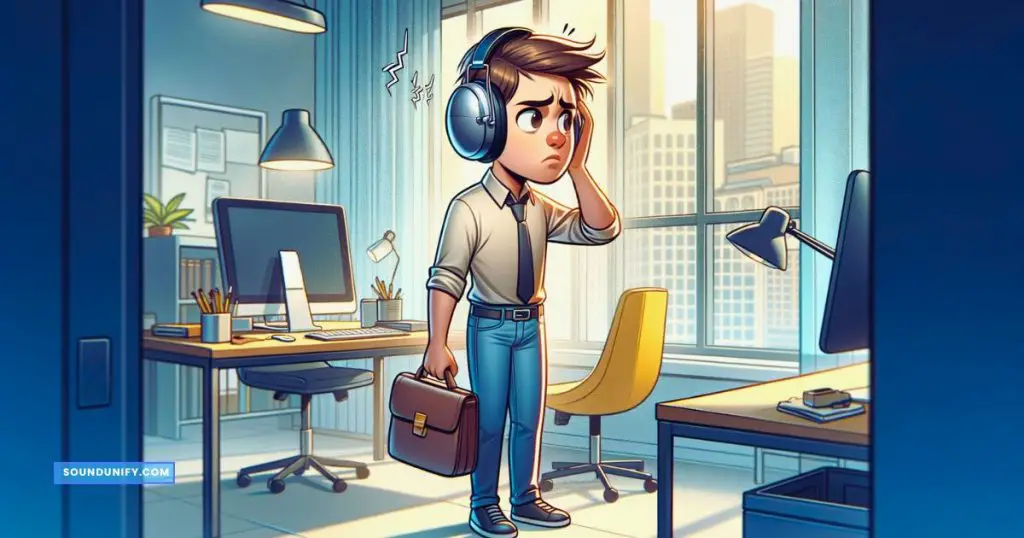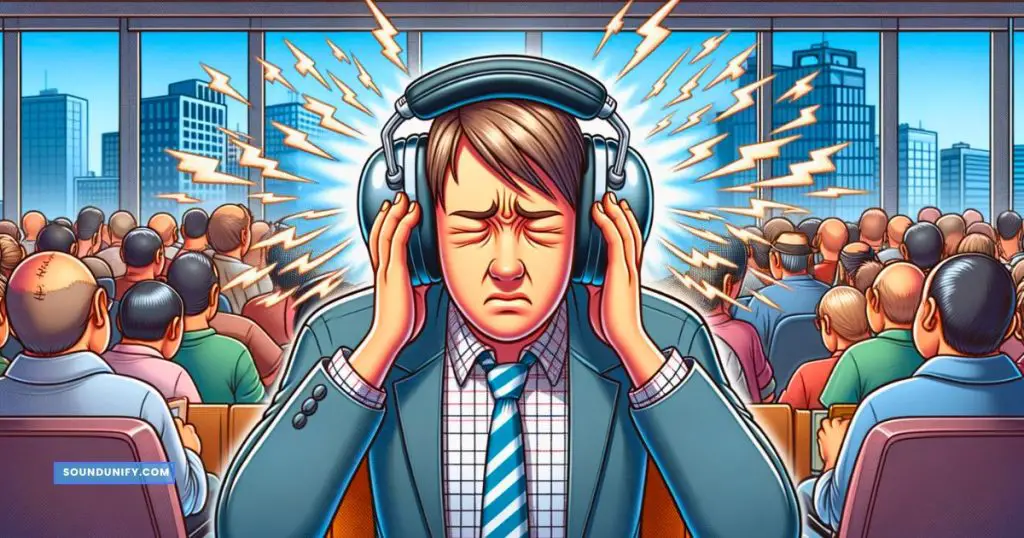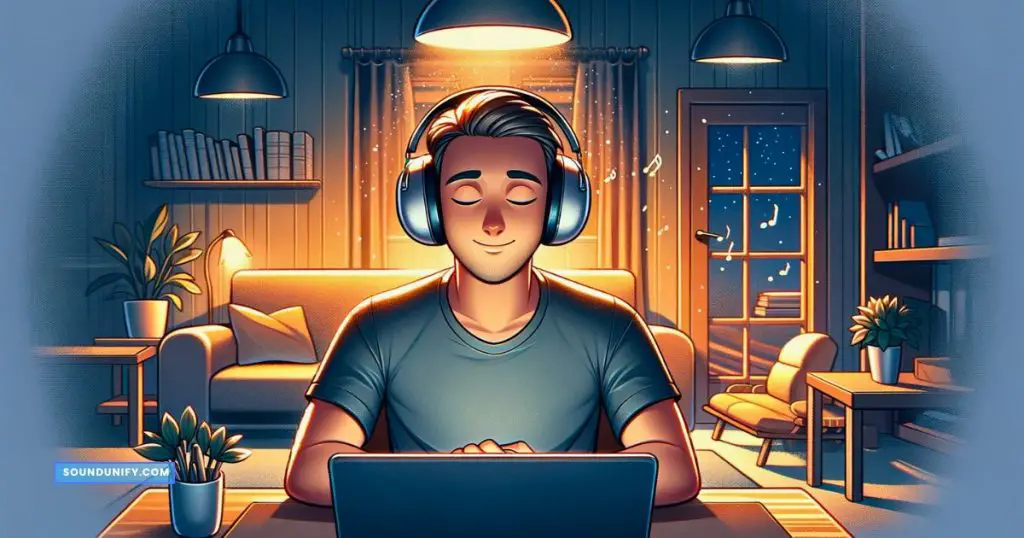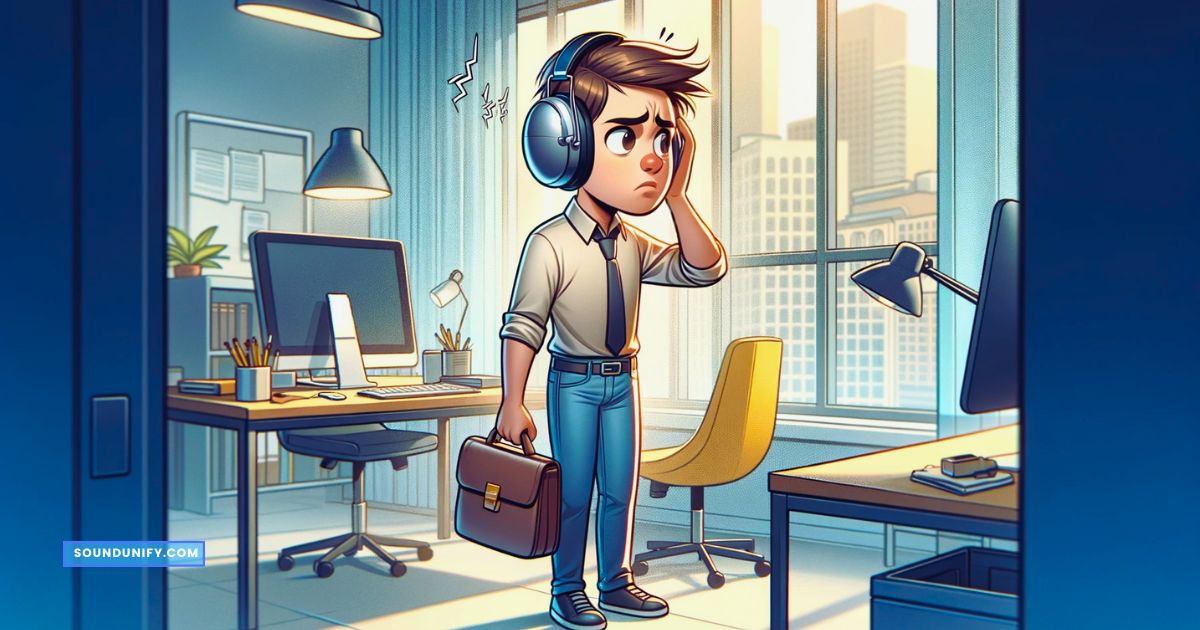Reducing the noise around us, allowing us to concentrate on our work, music, or conversations, is a fantastic benefit of noise-cancelling headphones. But can noise-cancelling headphones cause headaches?
With the emerging technology of noise-cancelling headphones, many people have begun asking this question. Could they be causing more harm than good?
This article will explore the potential effects of noise-cancelling headphones on headaches and how to avoid headaches from headphones.
Can Noise Cancelling Headphones Cause Headaches?

The short answer is that noise-cancelling headphones can cause headaches in some individuals. Headaches caused by noise-cancelling headphones are usually the result of prolonged exposure to very loud noises or excessive use of the product.
This is because many noise-cancelling headphones have a higher volume than regular earbuds, which can strain the ears and lead to headaches.
Additionally, when using noise-cancelling headphones with active noise-cancellation technology, users may experience a sensation of pressure in their ears, leading to headaches over time.
People prone to migraines may be more susceptible to headaches from noise-cancelling headphones due to their sensitivity to loud noises and changes in sound levels.
To determine if your headaches are related to using these devices, it’s important to take note of any potential triggers. Such as how long you have been using them at one time and whether or not they have been set too high or low for your comfort level.
Potential Causes of Headaches from Noise-Cancelling Headphones

Headaches are a common side effect of using noise-cancelling headphones. While some people may be able to use them with no adverse effects, others experience discomfort or pain after extended use.
It is important to know how they work to understand the potential causes of headaches from noise-cancelling headphones.
Noise-cancelling headphones utilize active noise cancellation (ANC) technology to block out external noise. This is achieved by using two microphone systems:
- One that picks up ambient sound and sends it to the ANC processor.
- Another sends an inverted signal through the headphone speakers to cancel out the original sound waves.
When this process is successful, it will provide a silence that would otherwise be unavailable without the ANC feature activated.
The potential causes of headaches from noise-cancelling headphones may include the following:
- Physical discomfort due to tight-fitting ear cups
- Wearing them for too long
- Exposure to loud sound levels
- Increased stress or fatigue caused by overstimulation from blocking out external noises.
Additionally, it has been suggested that some people are sensitive to frequencies generated by ANC technology, which can lead to headaches or other physical discomfort.
As such, if you are experiencing headaches while using noise-cancelling headphones, taking a break and assessing the source of the discomfort before continuing use is important.
8 Common Reasons Why Noise Cancelling Headphones Give Headaches

We explore eight reasons why noise-cancelling headphones can give headaches and discuss solutions that can help alleviate discomfort, from poor fit and sound quality to high-pressure levels and psychological effects.
1. Poor Fit and Adjustment
Regarding noise-cancelling headphones, fit and adjustment are crucial in providing optimal comfort and performance. If the headphones are not fitted properly, they can cause headaches due to the pressure on your head or ears.
Getting a proper fit for your noise-cancelling headphones is important, as they should be snug but comfortable. Poorly fitted headphones can be too tight, causing discomfort, or too loose, causing sound leakage, which may lead to fatigue from trying to keep the sound out.
2. High-Pressure Levels
High-pressure levels in noise-cancelling headphones can cause headaches for many users. This is because the ear cups are designed to create a seal around the ear, which helps block out external sounds.
When this seal is not perfect, or when the user increases the volume too much, these headphones can create pressure that can be uncomfortable or even painful.
3. Overheating Ears
When headphones are worn for too long or not adjusted correctly, they can press against the ears and trap heat, leading to a feeling of warmth or a burning sensation.
This is because soundproof materials used in noise-cancelling headphones, such as memory foam and synthetic leather, inherently retain more heat than other materials. As a result, the user’s ears can become very hot after prolonged use.
4. Excess Ambient Noise
Excess ambient noise is one of the major causes of headaches when using noise-cancelling headphones. Ambient noise can be any background sound not part of the audio playing in your headphones.
This could include traffic, construction, talking, and other loud noises. When these noises become too loud, or you are exposed to them for extended periods, they can cause a headache due to their intensity.
5. Psychological Effects of Constant Noise Cancellation
When using noise-cancelling headphones, you filter out specific sound frequencies while amplifying others.
This technique can create an environment that is constantly changing and unpredictable, leading to anxiety or stress, especially if you have difficulty concentrating in noisy environments.
Additionally, some people may find it difficult to relax in this environment because their brain always tries to adjust to sudden changes in frequency.
6. Overuse of Headphones in General
Using headphones for an extended period can cause uncomfortable headaches due to the constant pressure on our heads and ears.
When listening to music, podcasts, or any other audio source with headphones, it’s important to remember your body can only take so much strain from prolonged use.
While noise-cancelling headphones may help reduce the amount of sound coming in from the outside world, if you’re using them for too long, you might still experience headaches.
7. Unsuitable Music Genre or Audio Format
Choosing the right music or audio format is important when using noise-cancelling headphones. If you’re listening to something that is too loud or has too much bass, it can cause a headache.
This is because the sound waves are coming at your eardrums in an overly intense fashion, which can be uncomfortable and even painful. Additionally, depending on their sound composition, specific music genres may be unsuitable for noise-cancelling headphones.
For example, a genre like EDM (electronic dance music) is characterized by high-energy beats and heavy bass drops, which can be difficult to block when using noise-cancelling headphones. Listening to this type of music at a high volume can overwhelm the ears and result in a headache.
Even if you’re listening to softer genres like classical or jazz, you should still pay attention to the levels and make sure they don’t become excessive, as this could also lead to headaches from overstimulation of the ears.
8. Lack of Comfortable Ear Pads
The lack of comfortable ear pads is one of the most common reasons noise-cancelling headphones can cause headaches.
Many noise-cancelling headphones are designed with large, bulky ear cups that are not always comfortable to wear, and this can cause discomfort and pain in the ears after extended use.
Additionally, many noise-cancelling headphones do not come with soft or cushioning ear pads, making them even more uncomfortable to wear for extended periods.
How To Avoid Headaches From Noise Cancelling Headphones?

There are some simple steps to avoid headaches associated with headphones. Use headphones to prevent headaches and enjoy their benefits without pain.
1. Identifying the Cause of Headphone-Induced Headaches
Headphone-induced headaches are a common problem among people who frequently use headphones. The source of these headaches can vary, but it is important to identify the underlying cause to prevent them from occurring.
The headphones may be the culprit, as specific models are poorly designed and may cause discomfort or pain. Poor fit, inadequate cushioning, and stretched-out earpads can also contribute to this issue.
In some cases, listening to loud music for extended periods can lead to damage that results in headaches. Identifying and addressing any potential causes is key to avoiding headphone-induced headaches.
2. Investing in Quality Headphones
Investing in quality headphones is important in avoiding headaches from wearing them. High-quality headphones are designed to provide a comfortable and ergonomic fit and superior sound isolation, which can be key to reducing the risk of headaches.
Quality headphones also tend to have adjustable earcups, allowing for a better fit and more accurate sound reproduction.
Furthermore, these headphones often feature noise cancellation technology that can help reduce the amount of ambient noise reaching your ears.
Also, quality headphones usually come with replaceable earpads that can be cleaned regularly to keep them free from dirt and grime, adding to the discomfort of wearing headphones for long periods.
Investing in quality headphones is essential for those who want to avoid headaches and other ailments associated with wearing headphones for extended periods.
3. Wearing Headphones for Short periods
Wearing headphones for extended periods can be a great way to enjoy music, podcasts, or other audio content, but it can also cause headaches.
Limiting the time you use headphones and taking regular breaks in between is important to avoid this problem.
When wearing headphones for short periods, try to set an upper limit on your listening time and stick to it. For example, if you’re sitting at your desk working, only wear headphones for one hour before taking a half-hour break from them.
Doing so allows your ears to relax and recover from the pressure they endure while using them.
It is important to note that shorter periods may be necessary depending on the type and quality of headphones used and the volume settings used while listening.
4. Taking Breaks from Wearing Headphones
It is important to be mindful of the time spent with headphones on, as prolonged use can lead to headaches. Taking regular breaks from using headphones helps prevent headaches and other related symptoms.
After wearing headphones for a specific time, it is good practice to step away from them and allow your ears to rest. This can be done by engaging in another activity or taking time away from audio stimulation.
It is also beneficial to take a break every few hours when wearing headphones for long periods, such as during a work day or while studying.
Short breaks throughout the day help prevent tension from building up in the neck and head area, which can cause headaches.
During the break, one should engage in an activity that requires minimal effort, such as stretching or walking around the room.
5. Adjusting Volume Settings
Adjusting your headphone volume effectively avoids headaches caused by listening to music or podcasts. When the audio is too loud, it can cause increased pressure in your ear canals, leading to a headache.
The American Speech-Language-Hearing Association (ASHA) recommends keeping your headphones at no more than 60% of the maximum volume setting.
It’s also essential to adjust the volume based on the type of media you’re listening to, speech or music, as well as the sound quality of your headphones.
When adjusting your headphone volume, pay attention to any discomfort in your ears or head, as this could indicate that you have set it too high.
Experiment with different volumes until you find what works best, but prioritize safety over louder sound levels.
6. Using Noise Isolation Technology
Noise isolation technology is one of the most effective solutions for avoiding headaches from headphones. This technology reduces or blocks external noise so you can listen without turning the volume too loud.
Noise-isolating headphones typically feature specialized foam or silicone tips that fit snugly into your ear canal, creating an acoustic seal that reduces outside noise and provides a more immersive listening experience.
They are also typically lightweight and comfortable, making them ideal for long periods of use.
7. Ensuring a Comfortable Fit
Ensuring a comfortable fit is essential for avoiding headaches from headphones. It is important to ensure that the headband fits snugly on your head but is not too tight.
The earcups should also be adjusted properly to cover your ears without causing any discomfort or strain. If you experience any tightness or pain when wearing them, it is a sign that they may not be fitting correctly.
Selecting headphones with adjustable features such as swivel earcups and adjustable headbands is also essential. This will allow you to make minor adjustments to ensure the right fit and position for your comfort level.
Opt for over-the-ear models with more oversized earcups if you have long hair. This will help block out external noise and provide a more comfortable fit while preventing headaches from developing.
8. Cleaning Your Earpads Regularly
Good headphones can last for years with proper maintenance, but if you need to clean your earpads regularly, you risk more than just sound quality.
Earpads collect sweat and oils from your skin, dust and dirt from the air, and bacteria that can cause infections.
Over time, these substances build up and can cause discomfort or headaches when wearing headphones. Regularly cleaning your earpads will help reduce the risk of developing a headache while using headphones.
FAQs
What happens if you wear noise Cancelling headphones all day?
Wearing noise-cancelling headphones all day can lead to hearing loss, especially if the headphones have an excessive sound pressure level (SPL) that is too loud for extended periods. It can also lead to isolation, as you may be disconnected from all other sounds around you, and it can even contribute to headaches and fatigue from sensory overload.
How long can I wear noise Cancelling headphones?
It all depends on how loud the noise-cancelling headphones are. Generally, noise-cancelling headphones can be worn for up to 8 hours without causing any hearing damage. However, to be safe, only wearing them for 2-3 hours is best.
Can wearing headphones for too long cause headaches?
Yes, wearing headphones for too long can cause headaches. This is because the sound from headphones can be too loud and cause strain on the ear and tension in the neck and shoulders, leading to headaches.
Do noise-cancelling headphones cause headaches?
Noise-cancelling headphones can cause headaches in some individuals, particularly if they are sensitive to the pressure sensation created by active noise cancellation. However, this is not a universal effect and varies from person to person.
Does active noise cancelling cause headaches?
Active noise cancelling (ANC) technology in headphones can potentially cause headaches for some users. This is due to the way ANC works, by generating sound waves that cancel out external noise, which can create a sensation of pressure in the ears for some people.
Is it bad to sleep with noise-cancelling headphones?
Sleeping with noise-cancelling headphones is not inherently bad, but it can be uncomfortable or lead to ear pain due to prolonged pressure. There’s also a risk of missing important sounds like alarms or emergency signals.
Do noise-cancelling headphones have side effects?
Potential side effects of using noise-cancelling headphones include headaches, ear pain, or a sensation of ear pressure for some users. However, these effects are not experienced by everyone and can depend on individual sensitivity and the duration of use.
Conclusion
Noise-cancelling headphones can reduce unwanted noise while listening to audio. There are different types of noise cancellation, each with its advantages and disadvantages. However, some people may experience headaches when using noise-cancelling headphones.
Potential causes of these headaches include high sound pressure levels, extended use time, or a lack of physical awareness. If you are experiencing headaches due to the use of noise-cancelling headphones.
You can do several things, such as reducing your sound pressure levels or taking regular breaks from using headphones.
Noise-cancelling headphones can effectively reduce outside noise and provide a more enjoyable listening experience; however, it is important to take precautions to ensure that they don’t cause any adverse side effects like headaches or hearing loss.
James Dimento is a Chief-in-Editor of SoundUnify. He is a headphone enthusiast and creative writer passionate about audio technology. He has three years of experience writing about headphones and sound quality and is responsible for creating reviews and taking care of all administration.
